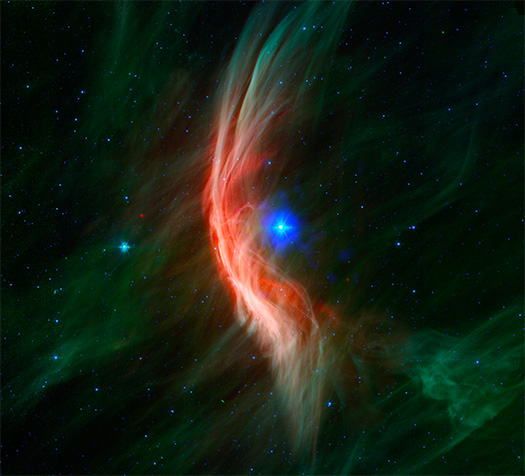Embracing a Rejected Star

Zeta Ophiuchi
Credit: X-ray: NASA/CXC/Dublin Inst. Advanced Studies/S. Green et al.; Infrared: NASA/JPL/Spitzer
Zeta Ophiuchi is a star with a complicated past, having likely been ejected from its birthplace by a powerful stellar explosion. A new look by NASA's Chandra X-ray Observatory helps tell more of the story of this runaway star.
Located about 440 light-years from Earth, Zeta Ophiuchi is a hot star that is 20 times more massive than the Sun. Previous observations have provided evidence that Zeta Ophiuchi was once in close orbit with another star, before being ejected at about 100,000 miles per hour when this companion was destroyed in a supernova explosion over a million years ago. Previously released infrared data from NASA's now-retired Spitzer Space Telescope, seen in this new composite image, reveals a spectacular shock wave (red and green) that was formed by matter blowing away from the star's surface and slamming into gas in its path. Data from Chandra shows a bubble of X-ray emission (blue) located around the star, produced by gas that has been heated by the effects of the shock wave to tens of millions of degrees.
A team of astronomers led by Samuel Green from the Dublin Institute for Advanced Studies in Ireland has constructed the first detailed computer models of the shock wave. They have begun testing whether the models can explain the data obtained at different wavelengths, including X-ray, optical, infrared and radio observations. All three of the different computer models predict fainter X-ray emission than observed. The bubble of X-ray emission is brightest near the star, whereas two of the three computer models predict the X-ray emission should be brighter near the shock wave.
In the future these researchers plan to test more complicated models with additional physics — including the effects of turbulence, and particle acceleration — to see whether the agreement with X-ray data will improve.
A paper describing these results has been accepted in the journal Astronomy and Astrophysics and a preprint is available here. The Chandra data used here was originally analyzed by Jesús Toala from the Institute of Astrophysics of Andalucia in Spain, who also wrote the proposal that led to the observations.
Please note this is a moderated blog. No pornography, spam, profanity or discriminatory remarks are allowed. No personal attacks are allowed. Users should stay on topic to keep it relevant for the readers.
Read the privacy statement
